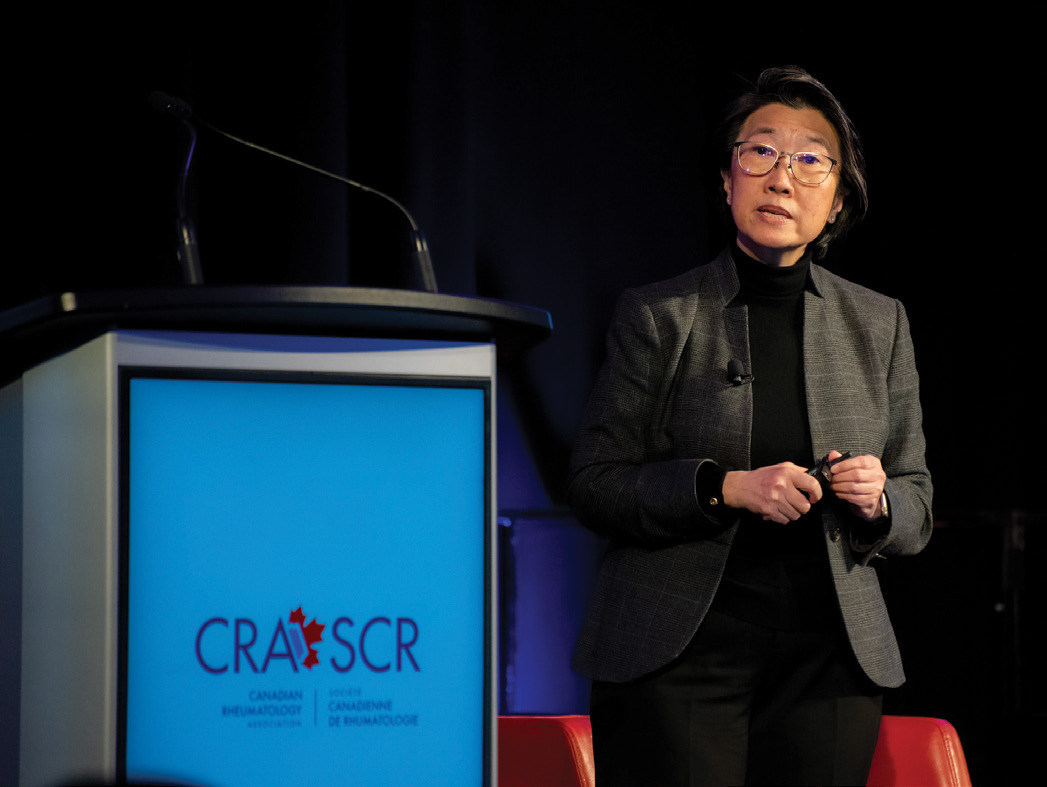Summer 2023 (Volume 33, Number 2)
Dunlop-Dottridge Lecture:
The Evolution of JIA
By Rae S. M. Yeung, MD, PhD, FRCPC
Download PDF

Dr. Rae S. M. Yeung provided the Dunlop-Dottridge Lecture
on the evolution of JIA at the CRA ASM in February 2023 in
Quebec City.
The Great Debate is a long-standing highlight of the
Canadian Rheumatology Association Annual Scientific
Meeting. This year, the debate extended to the
Dunlop-Dottridge Lecture, where the topic was the continuing
evolution of classification and nomenclature of juvenile
idiopathic arthritis (JIA). Good classifiers bring together
similar patients in the clinic and for research, where appropriate
comparisons are needed between studies and countries,
to improve treatment and access to medications. Current
classification systems for childhood arthritis are based
mainly on clinical phenotype, with a move to incorporate
more biology into future disease taxonomies. Features used
to currently categorize patients include age (above and below
16 years) and site of inflammation (arthritis versus enthesitis).
Basic laboratory findings include genetic underpinnings
of disease (HLA-B27), innate versus adaptive arms of
the immune system (systemic JIA versus non-systemic JIA),
and presence or absence of autoantibodies (rheumatoid
factor [RF]). Canada has a storied history in this debate,
and the Lectureship showcased Canadian contributions to
this journey.
The early descriptions of childhood arthritis were made
in the late 1800s by Sir George Frederic Still. The 1970s introduced
the great divide, with simultaneous but conflicting
approaches to nomenclature from the different sides of the
Atlantic. The juvenile rheumatoid arthritis (JRA) nomenclature
originated from the precursor of the American College
of Rheumatology (ACR), which was in contrast to the Juvenile
Chronic Arthritis (JCA) nomenclature used by the European
League Against Rheumatism (EULAR). The American
JRA classification had 3 subgroups and used the number
of affected joints as a cut-off to divide children into pauciarthritis
(≤ 4 joints) and polyarthritis (≥ 5 joints) and those
with systemic arthritis who had fever. The JCA nomenclature
proposed by the Europeans included 6 subgroups, with an
additional 3 subgroups corresponding to childhood forms
of adult rheumatic disease — juvenile rheumatoid arthritis,
juvenile psoriatic arthritis and juvenile ankylosing spondylitis.
The International League Against Rheumatism (ILAR),
brought the players together in 1997 to unify the nomenclature.
Canadians played a prominent role in the efforts at
consensus building, resulting in the current JIA terminology.
The ILAR criteria stratify patients into seven mutually
exclusive categories: systemic arthritis (sJIA), oligoarthritis,
RF-negative polyarthritis, RF-positive polyarthritis, psoriatic
arthritis, enthesitis-related arthritis, and undifferentiated
arthritis, with an age boundary of 16 years between childhood
and adult arthritis nomenclature.
The great debate continues today, with recent proposals
by the Pediatric Rheumatology International Trials Organization
(PRINTO) to develop a new classification schema.
Four PRINTO JIA subgroups are defined: three with adult
counterparts (systemic, RF-positive, and enthesitis/spondylitis-related JIA), and one unique to the pediatric population
(early-onset antinuclear antibody-positive JIA). Two additional
categories for unclassifiable patients are included: Other
JIA and Unclassified JIA. Using a Canada-wide inception cohort
of children with new onset JIA (ReACCH-OUT study),
we evaluated the ILAR and PRINTO classification schemes
and compared their alignment with each other. Unfortunately,
the two classification systems resulted in significantly
different groupings with only two exceptions — those with
sJIA and RF+ polyarthritis. Of note, two-thirds of all patients
with JIA were not able to be classified under the four
PRINTO subgroups.
Advancements in genomics have provided the opportunity
to integrate biology and clinical phenotype in classification.
The dramatic increase in the number of data points
has necessitated the use of machine learning and artificial
intelligence approaches for pattern recognition, allowing big
data to inform the classification system. Using a computational
biology approach, we identified 5 unique subgroups
of patients among children with JIA (excluding sJIA). The
resulting patient taxonomy was able to resolve differences
between patient subgroups better when compared to current
ILAR and PRINTO nomenclature. In most subgroups,
the clinical and biologic measures of disease activity and
inflammation were directly correlated. But importantly, in
two subgroups, clinically well-looking children had extremely
high levels of pro-inflammatory cytokines. These subgroups
of children with subclinical disease activity had a
worrisome disease trajectory, with increased disease activity
at follow-up, pointing to the contribution of expanded biologic
measures to improve the identification of children at
high risk for poor outcomes.
Research networks have been formed across the globe to
integrate biology into classification schemes towards this
promise of precision medicine. The Canadian-led Understanding
Childhood Arthritis Network (UCAN) was formed
for this purpose, as were other research consortia around the
globe. These groups together with others in the international
pediatric rheumatology research community agreed to a set
of principles for collaboration in childhood arthritis culminating
in the 2016 “London Declaration” — recognizing collaborations
as the norm, not the exception, when studying
JIA. The future is now, for this perfect storm of opportunities
to change the tone of the great classification debate.
Rae S. M. Yeung, MD, PhD, FRCPC
Professor of Paediatrics, Immunology & Medical Science
University of Toronto
Senior Scientist and Staff Rheumatologist,
The Hospital for Sick Children
Toronto, Ontario
|
